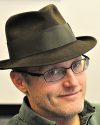- In 1896, Olof Hanson, the United States’ first deaf architect, designed Vang Lutheran Church in Dennison, Minn., with a square sanctuary and a horseshoe-shaped balcony that offered a clear view of the pulpit for anyone who needed to read lips. Photos: Courtesy of Vang Lutheran Church
- By the time Vang asked Hanson to design its building, he had an architecture practice in Faribault, Minn., that would eventually design 54 structures, including schools for the Deaf in three states.
Nearly a century before the Americans with Disabilities Act became law, a Minnesota church chose accessibility over tradition. The result is a functional monument to making worship more inviting to all, especially people with hearing impairments.
Vang Lutheran Church in Dennison, 50 miles southeast of Minneapolis, was established by Norwegian settlers and traces its roots to 1862. By the 1890s the congregation was outgrowing its original building, which was long and narrow like almost all Lutheran churches in the area.
For the new building, Vang turned to pioneering architect Olof Hanson, who proposed a revolutionary concept: a square sanctuary with a horseshoe-shaped balcony, a design that offered a clear view of the pulpit for anyone who needed to read the speakers’ lips.
“When I came and saw the sanctuary, I was very struck by it, and it’s definitely a source of pride in the congregation,” said Al Aakre, a recent graduate of Luther Seminary, St. Paul, Minn., who interned at Vang this spring. “It’s a beautiful sanctuary, and the members are active stewards in maintaining it.”
Born the same year as Vang, Hanson was a Swedish immigrant who had lost his hearing as a boy—first in his left ear and two years later in his right, when he was 13.
Hanson proposed a revolutionary concept: a square sanctuary with a horseshoe-shaped balcony that offered a clear view of the pulpit for anyone who needed to read lips.
Following his graduation from the Minnesota State Academy for the Deaf in Faribault, Minn., he enrolled at Gallaudet University in Washington, D.C., got a job as a draftsman, then traveled to Europe to study architecture. When he returned home and went to work in that field, he was recognized as the United States’ first deaf architect.
By the time Vang came calling, Hanson had a 2-year-old architecture practice in Faribault that would eventually design 54 structures, including schools for the Deaf in three states. He spent one month designing Vang’s new building, and construction started in July 1896.
The new sanctuary featured, in addition to its U-shaped loft, large windows for allowing light to stream into the worship area. Hanson’s design drew from the style of the Norwegian stave church, with soaring ceilings that form a Greek cross—one with four sides of equal length.
“People sit more in a group, they’re not divided by an aisle,” said Rene Koester, the congregation’s historian, whose family has been affiliated with Vang since its beginning. “What’s now stained glass originally had been clear, and the lighting in the church kind of has a golden color, the color of the oak woodwork.”
Prioritizing accessibility
Vang’s historic documents include a section titled “The Theology of the Vang Sanctuary,” which reads in part:
Hanson’s design at Vang does not diminish the importance of the audible Word but draws the worshiper into non-audible elements of worship. . . . People gather under the cross, yet also in the form of a cross, and thereby become the living presence of the suffering, crucified Christ in the world . . . . The invasion of outside light becomes a metaphor for the merciful God who enlightens the people who sit in darkness, as they await Jesus’ return.
“Human beings have always dealt with disability, and the gospel is full of people with disabilities of some sort,” Aakre said. “The architect was deaf, so he was well aware of the challenges of worshiping in a traditional church sanctuary.”
Lisa Heffernan, ELCA coordinator for disability ministries, marvels at the progressive thinking Vang showed in hiring Hanson and moving ahead with his unconventional design. “I think it’s amazing that they were that intentional back then,” said Heffernan, noting that getting society to think and act in terms of accessibility remains “a battle” today.
“The architect was deaf, so he was well aware of the challenges of worshiping in a traditional church sanctuary.”
Heffernan spends half her time working with Lutheran Campus Ministry at the University of South Dakota and the other half assisting congregations interested in improving accessibility. “We offer grants to congregations and ministries for programmatic and physical-access types of things,” the pastor said. “Sometimes it’s equipment so people can reach part of their church they couldn’t before, and other times it’s more specific, programmatic things. We’ll engage with congregations, camp systems and other groups for discussions on disability theology and disability ministries.”
Examples abound of ELCA congregations prioritizing accessibility, she said. Among them are Christ the King Lutheran Church in Cary, N.C., which started a choir for people with intellectual developmental disabilities; Holy Trinity Lutheran Church in Raleigh, N.C., which is undertaking multiple building projects related to accessibility; and Glenwood Lutheran Church in Decorah, Iowa, where the entire sanctuary, including the pulpit, has been made accessible.
“Soon we’ll be releasing a monthly blog where we will have different leaders, lay and rostered, share their stories about disabilities and the church,” Heffernan said.
One churchwide initiative, she explained, is the Evangelical Lutheran Deaf Association, an organization of Deaf congregations, “interpreted ministries” (which provide American Sign Language interpreters) and their members. Heffernan said “it’s something we’ll be very proud of and see develop into something a lot of people can connect with and will make more ministries happen.”






